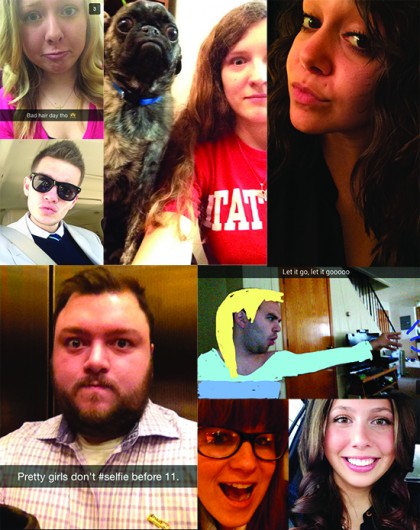
Photos courtesy of Jacob Hollar
When those crafty wordsmiths and perennial gatekeepers of the English lexicon assembled last year to honor a new word as the word of the year, they chose something remarkably more banal than one would ever dream of associating with those paragons of linguistic virtue.
They picked the word “selfie.”
The word wasn’t new to 2013, but it hadn’t until then been granted status as a proper, bona fide word. Ostensibly, it was coined circa 2002 in Australia while some anonymous person regaled an Internet chatroom with the story of a drunken mishap that resulted in both said person’s teeth protruding through said person’s lip and a low-quality picture taken of said person by said person.
Over the following decade, the word didn’t gain much traction — until it did.
As part of the selfie generation, I can’t say when exactly it happened or when I picked up the term. But at some point, I and my peers became obsessed with selfies.
Apps like Instagram and Snapchat fueled the fire, but the premise behind a selfie wasn’t new. It’s the modern self-portrait — and we as a species have been capturing our own image since time immemorial.
Why? I’m a self-avowed narcissist. I’m not sure what everyone else’s excuse is.
All right, that’s a lie — we’re all narcissists.
“D— straight,” my grandfather would say. “You whippersnappers are too full of yourselves.”
In truth, we’re no worse than any preceding generation (but that’s a different argument for a different time). We simply have the means to be more narcissistic more easily than our equally narcissistic progenitors.
From its humble (alleged) beginnings in early-2000s Australia, the selfie has become a pop cultural juggernaut.
The advent of hashtags, concurrent to the rise of the selfie, spawned such gems as #SelfieSaturday and, most recently, #AfterSex selfies.
To expand, the premise is what it sounds like: #AfterSex selfies are selfies (kind of, they often can involve at least one other person — you know, ‘cause that’s how sex usually works) taken post-coital.
To be fair, I think I deserve partial credit for this trend: I used to take pictures of my notoriously-sexually-active former-roommate’s “walks of shame.” She and I didn’t get along very well.
#AfterSex selfies are the new after-sex cigarette, except without the carcinogens.
Selfies have gone hand-in-hand (or whatever in hand) with the sexuality of the Internet era. Take Snapchat, an application some would argue was designed explicitly for sexting and selfies. Wanna send somebody a picture of your junk? Worried they’ll post it on the Internet and ruin your life like Anthony Weiner did to Anthony Weiner? No worries: Snapchat doesn’t allow saving pictures.
Sure, you can screenshot “snaps,” even (especially?) those of someone-you-know’s naught bits, but the spirit of selfies is that you don’t care.
For all their inherent narcissism, selfies, sexual and otherwise, are an eschewal of conservatism.
What that means is this: The implicit ideology behind taking a selfie is that the taker does not care what he or she looks like. It is an escapist contradiction of the formal portraits of years gone by.
Despite #AfterSex and all of the penises floating around Snapchat, the selfie is largely innocuous fun. They’re generally just goofy pictures of normal people making weird faces.
They are not ruining America. Ridiculous things like #AfterSex will fade away quickly into obscurity, but the short burst of joy that accompanies a friend’s horrifically contorted face will live on. Selfies are here to stay.


